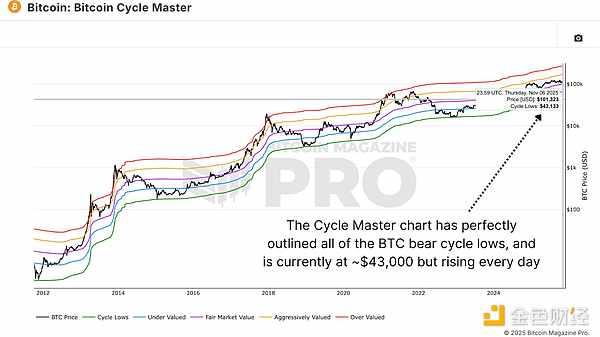Source: Grayscale X account
Author: Grayscale
Compiled by: Baishui, Jinse Finance
summary
Cryptocurrency valuations fell in early August amid concerns about the outlook for the U.S. economy and broader financial market volatility. Ethereum underperformed, likely due to increased positioning in the futures market and selling by a few large holders.
If the U.S. economy continues on its path to a “soft landing,” Grayscale Research expects token valuations to rebound.
However, even in a weaker economic environment, Grayscale Research has reason to believe that downside risk to prices may be more limited than in the past.
Crypto assets and broader financial markets stabilized midweek after experiencing sharp declines from Friday, August 2 to Monday, August 5 (Figure 1). Although major token prices generally have low correlations with other asset classes, volatility in traditional markets can affect cryptocurrency valuations.

Figure 1: Bitcoin and Ethereum fell in early August
The immediate cause of the decline was the weaker-than-expected July U.S. jobs report released on Friday, August 2. In particular, the report showed a rise in unemployment as large as in previous recessions. Fears of a cyclical recession led to weakness in cyclical assets such as equities, while traditional safe havens such as U.S. Treasuries, the Japanese yen, and the Swiss franc performed strongly (Figure 2). Non-U.S. equities and strategies that short U.S. equity volatility performed particularly poorly. Both Bitcoin and Ethereum fell; while Bitcoin performed relatively well on a risk-adjusted basis, Ethereum underperformed other crypto assets and many traditional market segments, as we will explore further below. Among the major crypto assets, Solana performed significantly better than other crypto assets.

Figure 2: Ethereum underperforming
Although Ethereum is more volatile than Bitcoin, its performance during the most recent decline was more pronounced than usual. For example, Figure 3 shows the largest percentage declines in Bitcoin price since 2020 and compares it to the decline in Ethereum price over the same period. During these events, Ethereum price typically declined by about 1.2 times as much as Bitcoin price. The latest “crypto winter” (i.e., bear market period) showed similar relative performance. In contrast, as of August 2024, Ethereum price has fallen by about 1.8 times as much as Bitcoin price, indicating that Ethereum faces additional, unique downward pressure.

Figure 3: On average, Ethereum’s decline is typically 1.2 times that of Bitcoin
One reason for the relatively large drop in Ethereum prices appears to be the excessive long positions in perpetual futures. In May 2024, traders increased their aggregate perpetual futures positions significantly around the time the U.S. Securities and Exchange Commission (SEC) approved the issuer’s 19b-4 application for a U.S. spot Ethereum exchange-traded product (ETP) (Chart 4), perhaps anticipating further price increases following full regulatory approval; that approval was received in July 2024, and the U.S. spot Ethereum ETP began trading shortly thereafter. Subsequently, some of these long positions were liquidated in the recent decline, accelerating the price decline. On August 4, the price of Ethereum fell 7.6% in just three minutes, with total perpetual futures liquidations reaching $340 million on that day alone. As the sell-off occurred during the U.S. overnight trading session and Binance’s spot price was at a large discount to Coinbase, the liquidations appear to have been led primarily by leveraged traders in Asia.

Chart 4: Increased leverage of Ethereum futures in May 2024
Another factor that may have contributed to Ethereum’s underperformance is actual and expected selling by a handful of large holders, including market maker Jump Crypto, venture capitalist Paradigm, and Golem Network, a crypto protocol with a large treasury holding of Ethereum. While the exact amount of the selling could not be determined, Grayscale Research estimated that these entities collectively held about $1.5 billion worth of Ethereum (based on Ethereum prices at the time) before they began moving tokens, according to data from analytics platform Arkham Intelligence. The decline in the number of active validators and the rise in Ethereum’s staking rewards rate also indicate a shift in the relatively sticky token supply, which could affect market sentiment.
Broader financial markets have stabilized over the past week. Perhaps most notably, the VIX index, which measures implied volatility in U.S. stocks, fell to 26% at the close on Thursday after reaching an intraday high of more than 60% on Monday (Chart 5). Whether markets can continue to stabilize will depend on upcoming macroeconomic and corporate earnings data, as well as any policy responses from the Federal Reserve or other central banks. On the economic data front, key upcoming reports include the weekly unemployment claims report (released every Thursday), the Consumer Price Index report (to be released on August 14), and the next employment report (to be released on September 6). The Fed is likely to cut interest rates at its meeting on September 18, but markets are more focused on the path of policy thereafter. Policymakers may provide more guidance at the Jackson Hole Symposium on August 22-24.

Figure 5: Market volatility has declined over the past week
If the U.S. economy avoids a recession and remains on a path to a “soft landing,” Grayscale Research expects token valuations to rebound and Bitcoin to retest its all-time highs later this year. However, even in a weaker economic environment, Grayscale Research has reasons to believe that downside risks to prices may be more limited than past declines. These include relatively stable net demand from new U.S.-listed ETPs, insufficient credit provided by centralized financial institutions during this cycle, and relatively lackluster returns on Altcoin since the beginning of the year. Changes in the U.S. political landscape surrounding the crypto industry may also reduce downside risks to valuations compared to past cycles.
Economic cycles are an inevitable feature of investing in almost all asset classes, and uncertainty in the macro outlook should be viewed as a short-term risk for crypto investors. At the same time, Grayscale Research believes that people have little tolerance for a severe economic recession and expects policymakers to start printing money and spending as soon as problems arise. Irregular practices in monetary and fiscal policy are one of the reasons why some investors choose to invest in Bitcoin; therefore, a period of economic weakness could strengthen the long-term investment thesis for Bitcoin.








